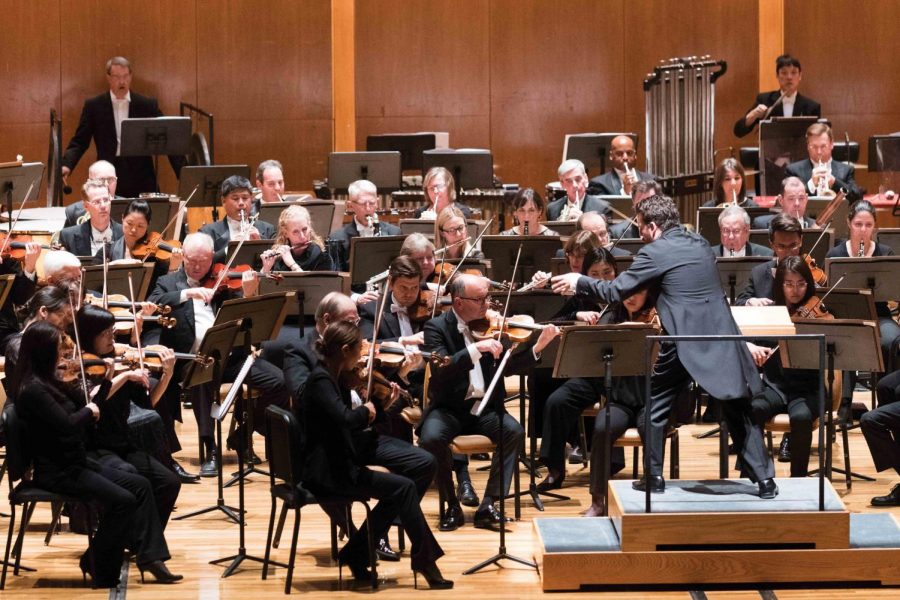Chicago Symphony Orchestra plays sold-out show
The Chicago Symphony Orchestra performed at the Krannert Center for Performing Arts on Saturday.
Oct 30, 2017
The Krannert Center for the Performing Arts hosted one of the finest symphonies in the world — a group that many music lovers pay a large amount of money to see in its hometown of Chicago.
The Chicago Symphony Orchestra visited the Krannert Center to a sold-out crowd, on Oct. 28.
Nick Puddicombe, co-director of Patron Services, said they expected over 2,000 attendees. His prediction wasn’t wrong. The lobby was flooded with patrons, from undistinguished students, to well-dressed, classy elites sipping red wine and whiskey.
It’s not often that a college student, or anyone, gets the opportunity to check out one of the world’s greatest symphonies for the low price of $10. Puddicombe credited the cheap tickets to last year’s student vote, which allowed them to maintain a $10 price.
“It had a great affirmation, over 75 percent voted a ‘Yes,’” Puddicombe said.
Get The Daily Illini in your inbox!
Puddicombe is highly involved in the production of shows at Krannert. To set up for the orchestra performance, Puddicombe said they came in with a couple semi-trucks full of road boxes, each containing an instrument. Krannert was cleaned before the performance, and space was set aside in Krannert’s underbelly so the orchestra could rehearse.
The orchestra performed three pieces, starting with Leonard Bernstein’s “Symphonic Suite” from the 1954 Marlon Brando movie “On the Waterfront.”
Then came Samuel Barber’s “Violin Concerto, Op. 14,” a fiddle-riddled masterpiece dominated by its chief violinist, James Ehnes.
The luscious opening suddenly turned playful, then moving, paused, became somber and then paused again. Finally, the solo violinist picked up speed, and the violinists around him set Ehnes up for a masterful finish.
Ehnes faced the crowd after his performance to acknowledge his love of the Krannert Center, specifically Foellinger Great Hall.
“This is one of the greatest halls anywhere,” Ehnes said.
He then performed an impromptu Bach solo, which was followed by an intermission.
Finally, for the third score, the orchestra performed Sergei Rachmaninov’s “Symphonic Dances, Op. 45.” This piece was written during the outbreak of World War II, just after Rachmaninov and his wife Natalya left Europe for the United States.
The 35-minute piece, the longest of the night, gave each group within the orchestra a chance to shine. The composer directed the separate classes of instruments to play individually and show off their gusto. This piece revealed the range of the orchestra. The tone shifted and percussion, brass, woodwind and string each got their chance to carry the piece. After the finale, the orchestra received a standing ovation.
The credit for the orchestra’s dynamism and excellence must be largely accredited to its conductor, the maestro James Gaffigan. He was energetic and intensely animated throughout the performance, appearing to be dancing with or in combat with each piece.
After the show, Gaffigan went into the donor’s room to shake hands with the donors and imbibe a little champagne. Once again, Gaffigan praised the “beautiful hall.”
“I think people forget that a great hall is like a great instrument for a great orchestra, so we were able to play soft, loud and be able to hear each other on stage,” he said.
For Ryan Schiffer, sophomore in Engineering, who played band in high school, seeing the orchestra was a joyful experience.
“I’m really amazed by the opportunity that the University has to bring the Chicago Symphony Orchestra here. I’ll definitely be returning next year,” Schiffer said.
Gaffigan also had some words for all the aspiring musicians in the audience, like Schiffer.
“I think you learn a lot about yourself in playing chamber music, in playing within an orchestra — being a part of a bigger picture. And I would just say, keep at it,” Gaffigan said. “It’s more than just a profession, it’s a lifestyle, and it’s very important.”






